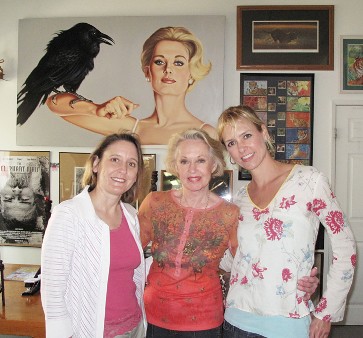Shambala Preserve

In Alfred Hitchcock’s film “The Birds”, actress Tippi Hedren tries desperately to escape from wildlife run amok, in the form of killer birds. In her real life, wildlife comes to her, escaping from human greed and short-sightedness . Ms. Hedren is the founder and driving force behind Shambala, a sanctuary in the California desert that is home to some 80 exotic cats, all of them rescued from conditions ranging from inappropriate to unspeakably horrible. A beautiful shaggy-maned lion, sprawled in the sun, was the pet and guard dog of a local drug dealer. A nearby leopard was being kept in an apartment by a well-meaning but clueless dentist. Many of the animals were purchased as infants by people besotted with their furry charm, and having no idea what it takes to raise such an animal.
The lives of most of the big cats bred and sold in the US end in tragedy. Purchased by private owners who are either unaware of their needs, or unconcerned, they live out lives of quiet desperation, in roadside zoos, as backyard ‘pets’ in small enclosures, or, as in the case of one leopard at Shambala, being kept in a closet all day. When the owners realize that they can no longer take care of the animal, or simply become bored with it, they often abandon it, or sell it to someone else, equally unprepared, and the animal begins the slow spiral from one bad situation to the next.
A few, a lucky, lucky few, find their way to Shambala, an accredited sanctuary that promises them a home for the rest of their lives – a home where they will have space to roam, warm beds to sleep in, high-quality food to eat, and a life free of harassment by humans. But places like Shambala are few and far between, and there will never be enough space and resources to care for all the animals rescued from the pet trade.

Tippi Hedren and me with Patrick, a liger (lion/tiger hybrid) who was being kept in such a cramped cage that he suffered muscle degeneration in his back and legs from being unable to move. He now resides at Shambala, where special ramps and housing have been built to accommodate his weakened legs. photo by William Dow
While Shambala is a accredited sanctuary, the words ‘sanctuary’ and ‘rescue’ are frequently used by breeders, sellers, and other participants in the pet trade, in order to make the public think that they are providing a service to the animals. Some of the tigers currently at Shambala came from a ‘rescue’ in California that was found to be breeding and selling animals to canned hunts and as pets. When the facility was raided by authorities, they found a ‘horror show’ – cats crammed into tiny cages, up to their bellies in feces and urine, the place so overcrowded that cubs were being stuffed into air conditioning vents and kitchen cupboards.
This is the sad beginning of many pet big cats in the US, and their lives usually end in the same sad way – in despair and illness. See my previous articles on public safety issues and humane issues regarding pet big cats, and what you can do to help stop this trade. In the meantime, please visit the website for Shambala to learn what else you can do to help.

Me, Tippi Hedren, and author and Shambala Advisory Board Member A.W. Gryphon (see link to review of her book "Blood Moon" below!)photo by William Dow
The lives of most of the big cats bred and sold in the US end in tragedy. Purchased by private owners who are either unaware of their needs, or unconcerned, they live out lives of quiet desperation, in roadside zoos, as backyard ‘pets’ in small enclosures, or, as in the case of one leopard at Shambala, being kept in a closet all day. When the owners realize that they can no longer take care of the animal, or simply become bored with it, they often abandon it, or sell it to someone else, equally unprepared, and the animal begins the slow spiral from one bad situation to the next.
A few, a lucky, lucky few, find their way to Shambala, an accredited sanctuary that promises them a home for the rest of their lives – a home where they will have space to roam, warm beds to sleep in, high-quality food to eat, and a life free of harassment by humans. But places like Shambala are few and far between, and there will never be enough space and resources to care for all the animals rescued from the pet trade.

Tippi Hedren and me with Patrick, a liger (lion/tiger hybrid) who was being kept in such a cramped cage that he suffered muscle degeneration in his back and legs from being unable to move. He now resides at Shambala, where special ramps and housing have been built to accommodate his weakened legs. photo by William Dow
While Shambala is a accredited sanctuary, the words ‘sanctuary’ and ‘rescue’ are frequently used by breeders, sellers, and other participants in the pet trade, in order to make the public think that they are providing a service to the animals. Some of the tigers currently at Shambala came from a ‘rescue’ in California that was found to be breeding and selling animals to canned hunts and as pets. When the facility was raided by authorities, they found a ‘horror show’ – cats crammed into tiny cages, up to their bellies in feces and urine, the place so overcrowded that cubs were being stuffed into air conditioning vents and kitchen cupboards.
This is the sad beginning of many pet big cats in the US, and their lives usually end in the same sad way – in despair and illness. See my previous articles on public safety issues and humane issues regarding pet big cats, and what you can do to help stop this trade. In the meantime, please visit the website for Shambala to learn what else you can do to help.

Me, Tippi Hedren, and author and Shambala Advisory Board Member A.W. Gryphon (see link to review of her book "Blood Moon" below!)photo by William Dow
You Should Also Read:
Shambala
A.W. Gryphon

Related Articles
Editor's Picks Articles
Top Ten Articles
Previous Features
Site Map
Follow @WildlifeWelfare
Tweet
Content copyright © 2023 by MaryEllen Schoeman. All rights reserved.
This content was written by MaryEllen Schoeman. If you wish to use this content in any manner, you need written permission. Contact Deb Duxbury for details.






